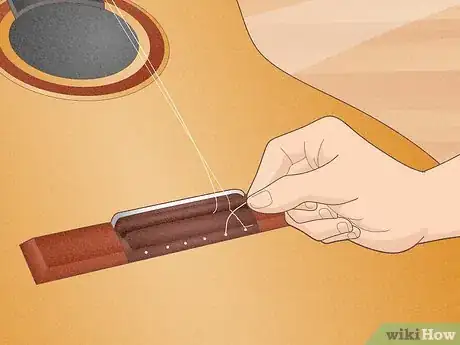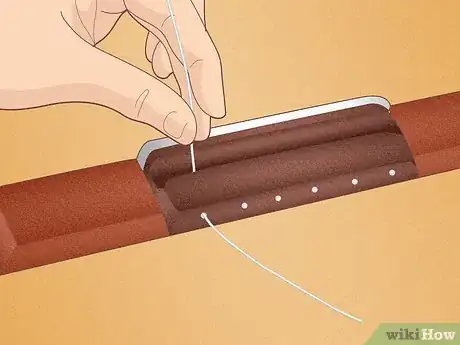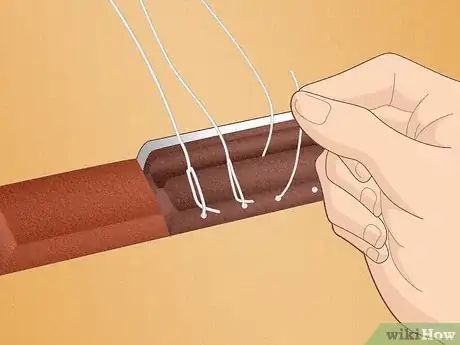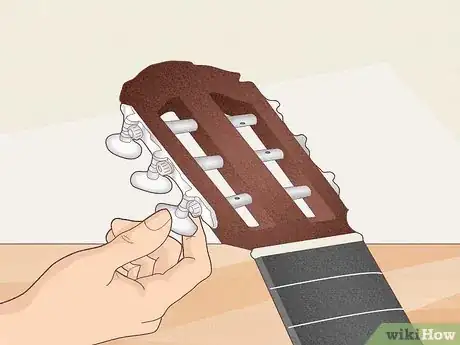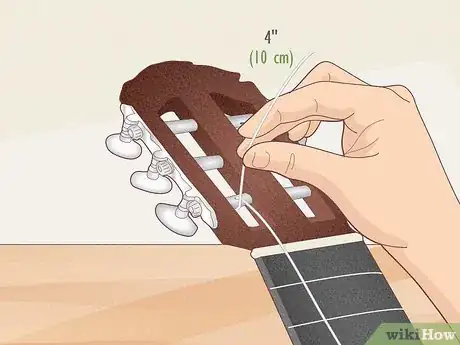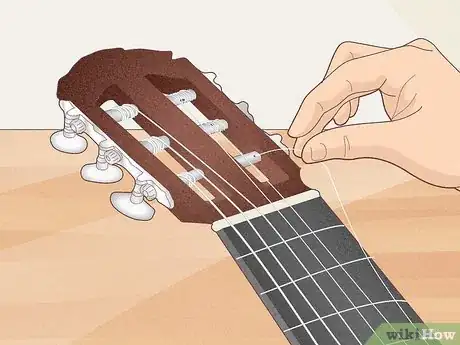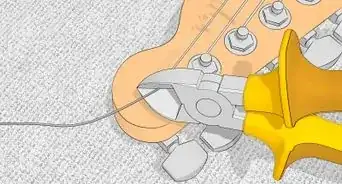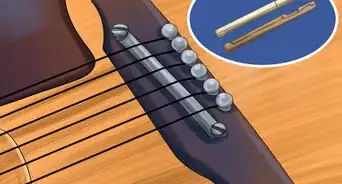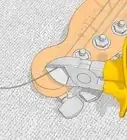This article was co-authored by Carlos Alonzo Rivera, MA. Carlos Alonzo Rivera is a guitarist, composer, and educator based in San Francisco, California. He holds a Bachelor of Arts degree in Music from California State University, Chico, as well as a Master of Music degree in Classical Guitar Performance from the San Francisco Conservatory of Music. Carlos specializes in the following genres: classical, jazz. rock, metal and blues.
There are 15 references cited in this article, which can be found at the bottom of the page.
This article has been viewed 528,625 times.
If your guitar strings buzz, sound blunt, or can no longer hold their tune, this may be a sign that it's time to change out the old strings. Many people who own classical guitars avoid string changes for a very long time because they don't want to mess up the knots at the bridge end or risk changing the sound of their guitar. But never fear. With a little effort, you'll be playing your newly strung and beautifully sounding guitar in no time!
Steps
Removing the Old Strings
-
1Use your finger or a string winder to loosen the 6th string from the neck. The 6th string should be the thickest string on your guitar. Attach the winder to the tuning peg and twist it in a circle until the string becomes loose enough to pull off the neck. If you don't have a winder, you can loosen it by hand instead (like you would to tune it down) until you can slide it out of the guitar.[1]
- If you're in a hurry, grab a pair of scissors and snip all six strings. Be sure to remove the small scrap parts around the bridge when you finish cutting.
- It's much safer to unwind the strings than to cut them so you won't have pieces of string flying off the guitar.
-
2Untie the string at the bridge and remove it. Once the string is loose enough, you should be able to undo the knot at the bridge by pushing the string back through where the knot was made. Pull the string back out of the hole to remove it completely from the guitar.[2]
- Safely dispose of the string in a trash can once you remove it from the guitar.
Advertisement -
3Remove all of the old strings from the guitar. Working your way down the rest of the guitar strings, remove them one by one until there are no old strings left on the guitar. If you prefer to change the strings one at a time, feel free to do this instead.[3]
- Removing the strings all at once can make it easier when you go to wind the new strings back onto the neck.
-
4Get a new pack of nylon strings. For classical guitars, you'll want to avoid buying steel strings. Instead, you can pick up your favorite pack of nylon strings at a local music shop or off the internet.[4]
- Never string a classical guitar with steel strings. This will put way too much pressure on the neck, eventually causing it to bend and crack.
Tying the New Strings to the Bridge
-
1Put the new 6th string through the corresponding hole in the bridge. Push it through the hole so that about 4–5 inches (10–13 cm) of string is sticking out towards the base of the guitar. Be sure that you're using the thickest string in your pack as the new 6th string.
- If one end of your new string has a rough texture while the other end is smooth, use the smooth end to loop through the bridge.[5]
-
2Loop the 6th string around once. You want it going under the other half of the string. It can be helpful to hold the string steady with your thumb and forefinger as you make the loop and eventually go to make the knot.[6]
-
3Tuck the string under the loop and pull to tighten it. As you do this, hold the string down against the soundboard. This is important because if you do not hold the string down, it will be sticking up. This will make it loose and it will probably come undone.[7]
- Be sure that the tail of the string comes down over the white lip before you tighten it. This will help to ensure that your knot stays tight.
- The main difference of changing strings on a classical guitar is tying the strings. On a classical guitar, there are no pegs to remove like on a steel string guitar. You have to thread the string through the hole in the bridge, loop it around, and tie it. Make sure the string is secure and string it up on the tuning peg.[8]
-
4Tighten the knot by pulling the string from both sides. You want it as tight as you can get it. Double check that the tail of the string reaches down over the white lip just before you tighten the knot. Tying the knot in the right spot will help to keep your string secure at the bridge.
- You can check your knot again when you go to attach the string to the neck later on. If it looks loose, redo the knot before you continue.
-
5Repeat with the 5th and 4th strings. The 6th, 5th, and 4th strings (usually E, A and D) are done in the exact same way, but the last three strings are done slightly different. It's mostly the same but you wind it around a few more times.[9]
-
6Attach the 3rd string using the same process, only tuck it under the loop 3 times instead of 1. Because the 3rd, 2nd, and 1st strings (usually G, B and e) are increasingly skinny, they can slip out of the knot that you tie at the bridge much more easily. To safeguard against this slipping, be sure to tuck the strings under their respective loop 2-3 times.[10]
- Put the string through the bridge as with the 6th, 5th and 4th strings.
- For the 1st string (the e string), some people like to loop the string around the hole twice for extra protection before tying the knot.
-
7Repeat with the 2nd and 1st strings. These last 3 strings can all be attached in the same way. Use particular care when you attach the 1st string as it is the smallest string and is more prone to slipping out of the knot you tie.
- Feel free to loop the 1st string through the hole twice before you tuck it under the loop and tighten.
- If any of the strings come loose, they can hit into the guitar and take out a small chunk of wood. Use extra care when tightening the knots around the bridge to ensure you keep your guitar safe.
Attaching the Strings to the Neck
-
1Turn the tuning peg for the 6th string until the hole is facing up. The string will be easier to work with if you can actually see what you're doing. The new string should be able to run through the hole vertically.
-
2Thread the new 6th string through the hole once. Push the end of the 6th string down through the corresponding hole on the neck. You can push a few inches of string through the hole to make it easier to grip.[11]
- Although there is another method where the string goes through the hole twice, this method is harder and the first way works just as well.
-
3Run the string back through the gap below the capstan. The capstan is the white plastic part that you wind the string around. You can pull the string back either above or below the capstan depending on your preference.[12]
-
4Pull the 6th string tight until there is about 4 inches (10 cm) of slack in the middle of the neck. You want to leave some slack so that you can tune the guitar without risk of breaking the new string.[13]
- This would be a good time to double check that the knot you made in the bridge is secure.
-
5Guide the string back through the loop above the capstan. You can do this either once or twice depending on your preference. This should keep the string secure when you wind it up.[14]
-
6Use your finger or a winder to rotate the tuning peg to tighten the string. Hold the loose string and tighten it up the same way you would to tune your guitar. Keep winding until the string is in tune. You can let go of the loose string after a while.[15]
- Cut off any excess string with a wire cutter. If there is any string sticking out from the head of the guitar, be sure to use a wire cutter to safely remove it. Otherwise, you could accidentally hurt yourself on the string when you go to play your guitar.[16]
-
7Repeat this process for every string. Working in order from the 6th string to the 1st string one at a time can help make it easier to properly attach the new strings to the neck of the guitar. Be careful not to tighten the strings so much that they snap, just like when you tune your guitar normally.[17]
- After you've attached all of your new strings use a tuner to help you get your guitar back in tune.
- Alternatively, you can attach the new E string before you remove the old A string, and tune the guitar to itself. To do this, play the E string at the 5th fret and match it to the sound of the A string.[18]
Community Q&A
Did you know you can get answers researched by wikiHow Staff?
Unlock staff-researched answers by supporting wikiHow
-
QuestionDo nylon strings go dead?
 wikiHow Staff EditorThis answer was written by one of our trained team of researchers who validated it for accuracy and comprehensiveness.
wikiHow Staff EditorThis answer was written by one of our trained team of researchers who validated it for accuracy and comprehensiveness.
Staff Answer wikiHow Staff EditorStaff Answer
wikiHow Staff EditorStaff Answer -
QuestionCan you use ball end strings on a classical guitar?
 wikiHow Staff EditorThis answer was written by one of our trained team of researchers who validated it for accuracy and comprehensiveness.
wikiHow Staff EditorThis answer was written by one of our trained team of researchers who validated it for accuracy and comprehensiveness.
Staff Answer wikiHow Staff EditorStaff Answer
wikiHow Staff EditorStaff Answer -
QuestionHow often should you change strings on a classical guitar?
 wikiHow Staff EditorThis answer was written by one of our trained team of researchers who validated it for accuracy and comprehensiveness.
wikiHow Staff EditorThis answer was written by one of our trained team of researchers who validated it for accuracy and comprehensiveness.
Staff Answer wikiHow Staff EditorStaff Answer
wikiHow Staff EditorStaff Answer
Warnings
- Never overtighten strings until they snap; this puts too much pressure on the bridge and it could fly off and hurt you.⧼thumbs_response⧽
Things You'll Need
- Guitar
- New pack of classical guitar strings
- String winder
- Wire cutter
References
- ↑ https://www.youtube.com/watch?v=AKsVF72Tsdg&feature=youtu.be&t=115
- ↑ https://www.youtube.com/watch?v=AKsVF72Tsdg&feature=youtu.be&t=123
- ↑ https://classicalguitarshed.com/change-classical-guitar-strings/
- ↑ https://classicalguitarshed.com/change-classical-guitar-strings/
- ↑ https://www.youtube.com/watch?v=AKsVF72Tsdg&feature=youtu.be&t=147
- ↑ https://www.youtube.com/watch?v=AKsVF72Tsdg&feature=youtu.be&t=182
- ↑ https://www.youtube.com/watch?v=AKsVF72Tsdg&feature=youtu.be&t=211
- ↑ Carlos Alonzo Rivera, MA. Professional Guitarist. Expert Interview. 18 August 2020.
- ↑ https://www.youtube.com/watch?v=4Cw84_0KHTI&feature=youtu.be&t=106
- ↑ https://www.youtube.com/watch?v=4Cw84_0KHTI&feature=youtu.be&t=120
- ↑ https://www.youtube.com/watch?v=4Cw84_0KHTI&feature=youtu.be&t=139
- ↑ https://www.youtube.com/watch?v=4Cw84_0KHTI&feature=youtu.be&t=139
- ↑ https://www.youtube.com/watch?v=AKsVF72Tsdg&feature=youtu.be&t=295
- ↑ https://www.youtube.com/watch?v=4Cw84_0KHTI&feature=youtu.be&t=143
- ↑ https://www.youtube.com/watch?v=AKsVF72Tsdg&feature=youtu.be&t=406
- ↑ https://www.artistguitars.com.au/view/classical-guitar-string-changing/135
- ↑ https://classicalguitarshed.com/change-classical-guitar-strings/
- ↑ https://www.youtube.com/watch?v=AKsVF72Tsdg&feature=youtu.be&t=413
About This Article
If your classical guitar strings buzz, sound blunt, or don't hold their tune, it's probably time to change them. To remove your old strings, loosen each string at the head and untie them at the bridge. You'll want to use nylon strings for your classical guitar, since steel strings can damage it. Tie your new strings to the bridge, looping each string around itself. Since the other 3 strings are thinner and can slip out, you’ll want to loop them 3 times before tying them. You'll thread each string through its hole in the headstock and tighten them by turning the knobs. For more tips from our Guitar co-author, including how to tune your classical guitar, read on!


